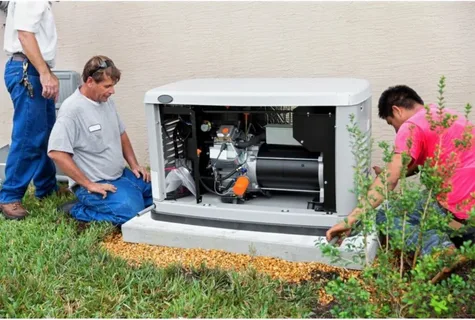Installing a generator can provide reliable backup power for your home or business, ensuring that you stay operational during power outages. However, if not done correctly, a generator installation can lead to inefficiency, safety hazards, or even expensive repairs. To ensure a safe and smooth installation, it is important to avoid certain mistakes that could compromise the functionality and safety of your generator system. In this article, we will explore the common mistakes people make during generator installation and provide tips on how to avoid them.
Why Proper Generator Installation is Crucial
Before diving into the mistakes to avoid, it’s important to understand why proper generator installation is so essential. A generator that is installed incorrectly can lead to:
- Electrical hazards: Improper wiring can cause electrical shocks or fire risks.
- System failure: A generator that’s not sized correctly or poorly maintained may fail to start during a power outage.
- Health risks: Incorrect ventilation can lead to dangerous carbon monoxide buildup, which can be deadly if not addressed.
To avoid these issues, it’s essential to take the necessary steps to ensure your generator installation is done correctly from the start.
Choosing the Wrong Size Generator
One of the most common mistakes during generator installation is selecting a generator that is either too small or too large for your needs.
- Too small: A generator that cannot meet your power requirements will struggle to run all your essential appliances. Overloading the system can lead to frequent breakdowns and early wear and tear.
- Too large: On the other hand, an oversized generator wastes fuel and can lead to unnecessary operational costs. Additionally, larger generators may not operate as efficiently under light loads, which can affect their longevity.
How to Avoid This Mistake:
Before purchasing a generator, carefully assess your power needs. Make a list of the appliances or devices you need to power during an outage and calculate their total wattage. From there, choose a generator that provides slightly more power than required for safety and efficiency.
Improper Placement of the Generator
The location of your generator is crucial to its safe and effective operation. Many people make the mistake of placing their generator too close to their home or in an enclosed space, like a garage or basement.
- Carbon monoxide buildup: Generators emit carbon monoxide, a colorless, odorless gas that can be deadly if inhaled in high concentrations. Installing a generator in an enclosed space or too close to your home increases the risk of carbon monoxide poisoning.
- Lack of ventilation: Generators need proper airflow to operate efficiently. Installing a generator in a poorly ventilated area can cause it to overheat or malfunction.
How to Avoid This Mistake:
Install your generator outdoors, at least 5 feet away from windows, doors, and vents to prevent the buildup of exhaust fumes in your living areas. Ensure that the generator is in a well-ventilated area where it can receive adequate airflow and operate without obstruction.
Failing to Hire a Professional for Installation
While portable generators may seem like easy DIY projects, standby generators often require professional installation. Attempting to install a generator without proper training can result in wiring issues, grounding problems, and other electrical hazards.
- Incorrect wiring: Improperly connecting your generator to your electrical system can cause power surges, damage to your appliances, or create fire hazards.
- Inadequate grounding: If your generator isn’t grounded properly, it may not function properly, and you could face the risk of electrical shock.
How to Avoid This Mistake:
Always hire a licensed and certified electrician for the generator installation. Professional installers will ensure that all electrical connections are secure, the generator is properly grounded, and it meets local building codes.
Ignoring Maintenance Requirements
Generators require regular maintenance to remain in good working order. Many homeowners make the mistake of neglecting maintenance tasks until an emergency arises, which can result in system failure when the generator is needed most.
- Fuel and oil checks: Not monitoring fuel levels and oil changes can lead to engine failure or performance issues during power outages.
- Air filter and spark plug issues: Neglecting to clean or replace air filters and spark plugs can cause your generator to run inefficiently or fail to start.
How to Avoid This Mistake:
Make sure you schedule regular maintenance for your generator, including fuel checks, oil changes, and filter replacements. Keep track of the manufacturer’s recommended maintenance intervals, and perform the necessary tasks to ensure your generator is always ready to go.
Forgetting About the Transfer Switch
A transfer switch is a critical component in any generator installation. It allows your generator to safely connect to your home’s electrical system without backfeeding into the grid. Failing to install a transfer switch or using a manual transfer switch improperly can cause serious electrical hazards.
- Backfeeding: This occurs when power from your generator is fed back into the utility lines, which can electrocute utility workers trying to restore power to your area.
- Overloading circuits: Without a proper transfer switch, you may accidentally overload certain circuits by powering appliances that require more energy than the generator can provide.
How to Avoid This Mistake:
Always install an automatic or manual transfer switch that meets local codes and ensures the safe operation of your generator. A certified electrician will help you choose the right transfer switch for your needs and handle the generator installation properly.
Not Accounting for Noise Levels
Generators can produce significant noise, which may be disruptive to you, your family, or your neighbors. Choosing a noisy generator or not considering its placement can cause unnecessary disturbances.
How to Avoid This Mistake:
When selecting a generator, check its decibel (dB) rating and opt for a quieter model if noise is a concern. Additionally, place the generator away from bedrooms or quiet areas, and consider building a soundproof enclosure if needed.
Overlooking Local Codes and Regulations
Each area has specific regulations regarding the installation of generators, including zoning laws, noise restrictions, and safety codes. Failing to comply with these rules can result in fines, delays in installation, or even the need to move or re-install the generator.
How to Avoid This Mistake:
Research your local building codes and regulations before purchasing a generator. Ensure that your generator installation and its components comply with all zoning laws, electrical codes, and environmental guidelines. A professional installer will help ensure that your generator installation meets all necessary legal requirements.
Failing to Plan for Fuel Storage
If you’re installing a portable generator, it’s important to have a reliable fuel storage system in place. Many people make the mistake of not properly storing fuel or not keeping enough on hand for long outages.
- Fuel spoilage: Gasoline, in particular, has a limited shelf life and can spoil if not stored properly. Using stale fuel can cause your generator to malfunction.
- Inadequate storage: Storing fuel indoors or in unsafe conditions can lead to fire hazards.
How to Avoid This Mistake:
Store your fuel in an outdoor, well-ventilated, and approved container. Make sure to rotate your fuel supply every 6 to 12 months to prevent it from spoiling.
Not Considering Long-Term Costs
While purchasing a generator is a significant investment, many people fail to consider the long-term costs associated with its operation and maintenance. This can include fuel costs, repair expenses, and maintenance fees.
How to Avoid This Mistake:
Consider both the initial purchase cost and the ongoing costs when selecting a generator. Choose a generator that fits your budget for both installation and long-term operation.
Conclusion
Avoiding these common mistakes during generator installation is key to ensuring the safety, efficiency, and longevity of your backup power system. By selecting the right size generator, installing it in an appropriate location, using a professional installer, and following all safety and maintenance guidelines, you can ensure that your generator will perform reliably when you need it most.
FAQs
1. Can I install a generator myself?
While some portable generators can be set up by homeowners, generator installation for standby generators should always be done by a professional to ensure proper wiring, grounding, and compliance with local codes.
2. What’s the best location to install a generator?
Your generator should be placed outdoors, at least 5 feet from windows, doors, or vents. Ensure it is in a well-ventilated area to avoid carbon monoxide buildup.
3. How often should I service my generator?
Generators require regular maintenance, such as oil changes, air filter replacements, and fuel checks. Refer to your generator’s manual for specific maintenance intervals.
4. Is a transfer switch necessary for generator installation?
Yes, a transfer switch is essential for safely connecting your generator to your home’s electrical system. It prevents backreading and ensures the safe use of the generator.

